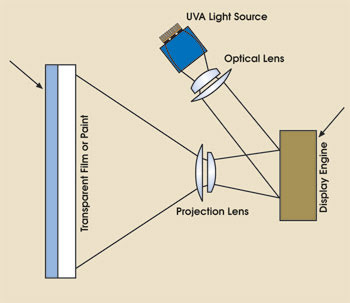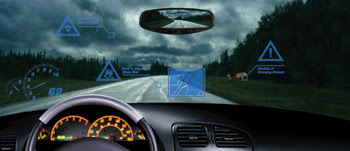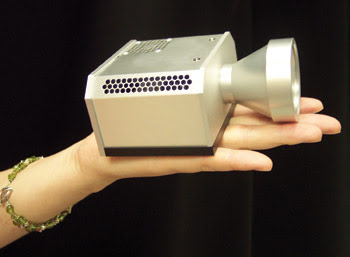A projection system with fluorescent conversion technology allows the size and angle of an automotive display to be almost limitless.
Ted Sun and Jianqiang Liu, SuperImaging
A major problem with ever-more-sophisticated automobiles is the growing amount of information provided to drivers. Increased information in dashboard displays diverts eyes from the road, creating a distraction that can lead to accidents. Head-up displays augment dashboard information but are limited in size and viewing angle.
A full-windshield projection system using a fluorescent conversion technology could help alleviate this problem. SuperImaging Inc. of Fremont, Calif., recently developed a system in which the entire windshield (or any substrate) is covered with a special fluorescent coating that is fully transparent. The area of coverage becomes an emissive screen for the transparent display, called a TransPlay. The film converts a UVA dark image projected from either a digital light processor (DLP) or 2-D laser scanner into a fluorescence visible image on the windshield substrate (Figure 1).

Figure 1. This schematic shows SuperImaging’s transparent display technology.
A color image also can be rendered on a transparent screen with a customized DLP projector. Unlike other emissive display technologies, such as cathode-ray tube (CRT) or plasma, the transparent display uses a homogeneous, structureless fluorescent screen to eliminate the need for projector-to-screen alignment. Vertically stacked, three layers of transparent fluorescent films corresponding to the emissions of the red, green, blue (RGB) primary colors can be addressed separately by excitation light of multiple discrete wavebands. These RGB materials on the transparent screen cover a range of color similar to that of CRT or plasma displays (Figure 2).

Figure 2. The full-windshield display can include warning signs and signals, street maps and other information in colors that are visible even in sunlight.
Laser projector
While a DLP projector is preferable for presenting video images, the company also has developed a transparent display with a laser projector, called laser TransPlay. A two-color windshield display system was recently constructed based on a custom-developed palm-size laser projector (Figure 3).

Figure 3. The display technology uses a palm-size projector that receives the image through a UVA light source and shines it onto a windshield that is coated with a transparent film.
Similar to DLP TransPlay, the laser system has two vertically stacked transparent fluorescent films applied to cover the entire windshield. With the laser projector mounted on the ceiling or under the dashboard of a vehicle, it takes up minimal space. It also doesn’t require its own power source because it operates off the 12-V supply from the automobile.
The entire windshield display system can show dynamic information such as flashing warning signs, a global positioning system map with street names, and potential hazards such as a cow, deer or human moving across the road, with lane markings shown in real time. The display is very bright, and the information is clearly visible in the daytime. The projector digitally corrects for the curvature or distortion of the windshield, and the multicolor image can be viewed from anywhere inside the vehicle.
As with any technology introduced in automobiles, extensive product safety and lifetime testing is required, in addition to adequate human/machine interface study. Preliminary testing of this system shows satisfactory robustness with continuous operation in harsh environments. The display can be configured so that the laser beam is inaccessible to humans, with a power level below the safety limit set by the International Electrotechnical Commission (IEC 60825).
Meet the authors
Ted Sun and Jianqiang Liu are co-founders of SuperImaging Inc. of Fremont, Calif.; e-mail: [email protected]; [email protected].